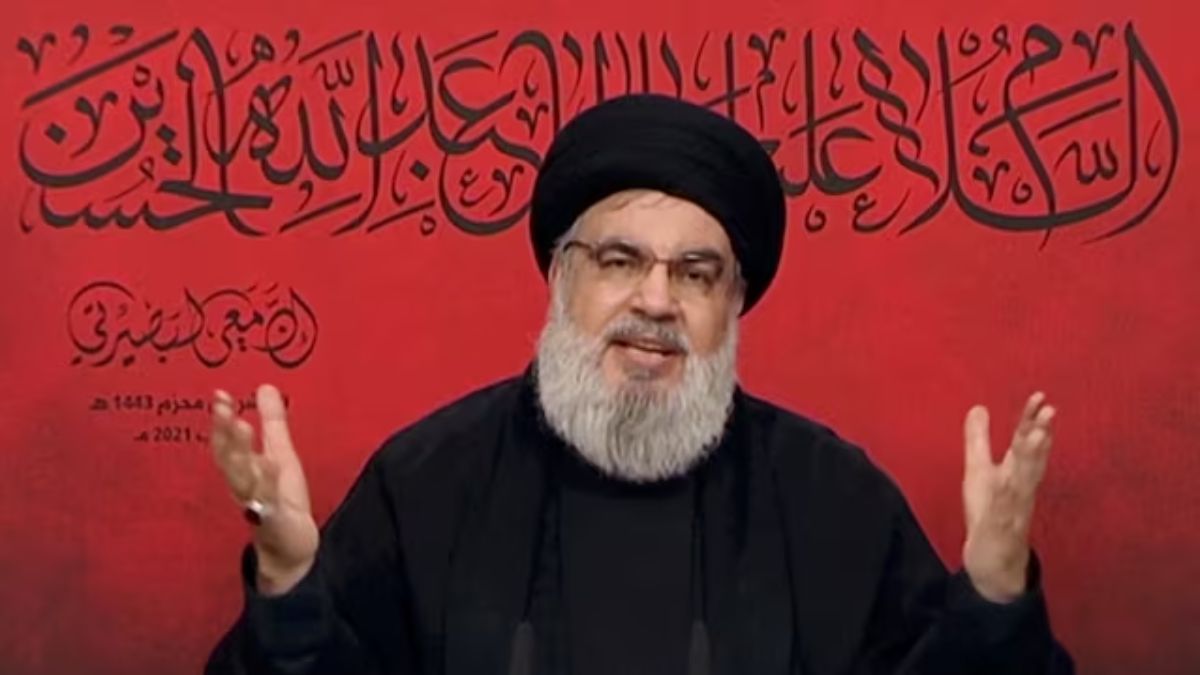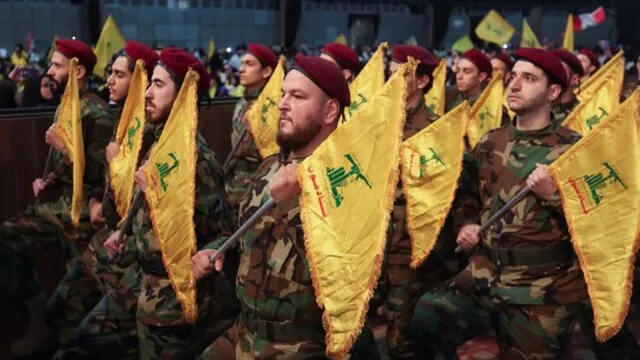- By Imran Zafar
- Mon, 26 Aug 2024 08:53 PM (IST)
- Source:JND
Hezbollah and Israeli forces intensified their exchange of attacks along the Lebanon-Israel border, marking a significant escalation in their conflict since October 7. On Sunday, Israeli jets conducted a ''preemptive strike'' on southern Lebanon, targeting alleged Hezbollah rocket launchers that were reportedly preparing to strike Israel. The Israeli military claimed it detected a planned Hezbollah missile launch towards central Israel and launched the attack with 100 jets thirty minutes before the projected strike.
In response, Hezbollah chief Hassan Nasrallah announced the group had fired hundreds of drones and rockets at northern Israel, avenging the recent death of commander Fuad Shukr. Hassan Nasrallah also contested Israeli claims that their military had neutralised Hezbollah’s rocket launchers.
The recent escalation between Hezbollah and Israel has heightened concerns about a larger conflict in the Middle East, potentially drawing in more participants. Here's everything you need to know about Hezbollah, its leader Hassan Nasrallah and the group's political and military strengths that could influence the regional conflict.
Hezbollah: Origin And Political Role
Hezbollah, which translates to 'Party of God,' is a Lebanese Shia Islamist political and paramilitary organisation. Hezbollah has evolved into a significant political force since its establishment in 1982 by Lebanese clerics to combat the Israeli invasion. The organisation likely adheres to the Wilayat e Faqih model (where a religious cleric heads the state), inspired by Ayatollah Ruhollah Khomeini's ideology.
Hezbollah's military and political wings include the Jihad Council and the Loyalty to the Resistance Bloc, respectively, with the latter holding seats in the Lebanese Parliament. Hezbollah is known for its considerable military capabilities, which were assessed in 2016 as comparable to a medium-sized army.
-1724684764562.jpg)
Mourners carry a coffin during the funeral of Wissam Tawil, a commander of Hezbollah’s elite Radwan forces who according to Lebanese security sources was killed during an Israeli strike on south Lebanon. (Image: Reuters)
Under the leadership of Hassan Nasrallah, who has led the group since 1992, Hezbollah has transformed from a local militia into the largest political party in Lebanon. The 2018 parliamentary elections saw Hezbollah securing over 3,40,000 preferential votes, the highest for any Lebanese party since the country's independence.
How Powerful Is Hezbollah's Chief Hassan Nasrallah
Hassan Nasrallah, a prominent Shia leader whose name translates to "victory through God," has significantly influenced Lebanon and the broader Arab-Israeli conflict. His leadership has positioned Hezbollah as one of the most formidable non-state armed groups globally, with estimates of around 100,000 fighters. Nasrallah’s speeches and strategic decisions continue to shape regional dynamics and impact Hezbollah’s reputation across the Arab world.
Supported by Iran, Hezbollah is integral to Iran's Axis of Resistance, aligning with various regional allies including the Syrian government, Houthis in Yemen, Islamic Jihad and Hamas in Palestine and several of Iraq’s popular mobilisation groups. Hasan Nasrullah is a powerful voice and a leader of this alliance in the Middle East which can act against the Israeli regime and can hurt US interests in the region.

Lebanon's Hezbollah leader Sayyed Hassan Nasrallah speaks through a screen during a religious ceremony marking Ashura, in this screengrab taken from Al-Manar TV footage.
Hezbollah leader Hassan Nasrallah praised the Hamas-led Al-Aqsa Flood attack as a "heroic" and effective action, though he clarified that neither Hezbollah nor its allies were forewarned. Notably, the militant group has also allowed Palestinian fighters to stage attacks against Israel from south Lebanon. The strategy is intended to ease pressure on Hamas by tying up Israeli forces elsewhere and eventually forcing a permanent ceasefire in Gaza.
ALSO READ: Arbaeen Walk: Why 2 Crore Muslims Converged In Iraq As War Looms Over Middle East | Explained
Hezbollah-Israel Conflict Timeline
8 October 2023: Hezbollah initiated attacks on Israeli positions along the Lebanese-Israeli border in solidarity with Palestinians after Hamas's surprise attack on southern Israel on 7 October 2023. This action marked the beginning of daily cross-border strikes, raising fears of a broader regional conflict.
14 August 2006: The 33-day war between Hezbollah and Israel ended with UN Security Council Resolution 1701, mandating a strengthened UN Interim Force and the Lebanese army to secure the southern border region.
14 July 2006: Hezbollah fires a surface-to-sea missile at the Israeli naval ship Hanit, killing and wounding crew members, as part of escalating cross-border exchanges that result in over 1,200 Lebanese and 160 Israeli deaths.
May 2000: Israel unilaterally withdrew from southern Lebanon, ending its occupation of Arab territory.
Mid-1990s: Hezbollah intensified military operations in the Israeli-occupied zone, engaging in guerrilla warfare aimed at recovering territory and enabling displaced people to return home.
1982: Hezbollah was founded by Lebanese Shia clerics primarily to fight the 1982 Israeli invasion of Lebanon. The event marked the start of a persistent conflict with Israeli forces, characterised by continuous exchanges of fire and rocket attacks each year.
Hezbollah Vs IDF Military Comparison
Tabular comparison of the military capabilities of Hezbollah and Israel, focusing on key aspects for clarity:
Aspect | Hezbollah | Israel Defense Forces (IDF) |
Active Personnel | About 1,00,000; exact numbers not disclosed | About 1,73,000 active, plus 3,00,000 reservists |
Rockets & Missiles | Over 150,000 rockets and missiles | Advanced missile systems including Arrow and Iron Dome |
Rocket Models | Iranian-made Raad, Fajr, Zilzal; Russian-made Katyusha | Various U.S.-made systems; Iron Dome for defence |
Anti-Tank Missiles | Kornet, Iranian Toophan (reverse-engineered TOW) | Advanced tanks (Merkava); anti-tank missiles |
Anti-Ship Missiles | Russian-made Yakhont | Advanced naval systems, including Iron Dome for naval |
Drones | Locally assembled Ayoub and Mersad models | Advanced drones for reconnaissance and strike |
Air Defence Capabilities | Surface-to-air missiles, limited drone interception | Iron Dome, David's Sling, Arrow systems |
Tanks | Limited; not a primary focus | About 2,200 tanks, mainly Merkava |
Artillery | Basic artillery; focus on rockets and missiles | 300 towed artillery pieces, 650 self-propelled guns, 300 rocket artillery systems |
Air Force | Limited; occasional use of surface-to-air missiles | Strongest in the region; includes Kfir and F-35 jets |
Special Forces | Effective in guerrilla tactics | Highly trained units like Sayeret Matkal |
Budget | Limited resources; primarily Iranian and local support | About USD 24.3 billion, substantial US aid |
Overall Military Approach | Rocket barrages, asymmetric tactics | Conventional military with advanced technology and support infrastructure |
This table captures the main elements of military strength and capabilities for both Hezbollah and the IDF. (Info source: Newsweek)

